How to Choose the Right Motion Sensor? Selection Guide by Installation Environment and Application
To operate motion sensors effectively, it is essential to select the right product based on the installation environment and operational needs. Whether for indoor or outdoor use, choosing a sensor that matches the surrounding conditions and intended purpose helps prevent false detections and ensures stable performance.
This article provides a detailed guide to selecting motion sensors by application and environment, focusing on key points to prevent false alarms and achieve reliable detection.
**For a detailed overview of the principles and technical features of motion sensors, please refer to this article.
1. Selecting the Right Product Based on Installation Needs / Location
■ When installation time needs to be minimized
Wireless motion sensors are effective when building structures or wiring constraints are present. Since no cabling work is required, they can be installed much faster than wired models and are well-suited for retrofitting into existing facilities.
■ Detection Area: Distance and Shape
Detection distance and angle (i.e., the shape of the detection area) vary depending on the sensor model.
By selecting a product that best fits the area you want to monitor, you can narrow the detection range to exclude unnecessary factors and efficiently monitor only the required zone.
- Wide-angle type: Ideal for open spaces where broad coverage is needed.
- Narrow-angle type: Suitable for monitoring specific directions such as property boundaries or pathways. These sensors can be configured to exclude potential sources of false alarms from the detection area.
OPTEX provides a comprehensive lineup of motion sensors designed to accommodate diverse detection ranges and angles, ensuring optimal performance across different security applications.
▶ See all Outdoor Motion Sensors
▶ See all Indoor Motion Sensors
Some our sensors offer flexible setting options, allowing users to adjust detection range and angle simply by flipping the lens or changing settings via a switch.
Below are examples.
FTN Series
Detection range can be switched from 5m to 2m.
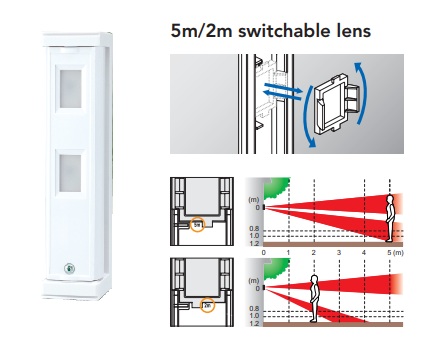
| Model | FTN-ST | FTN-AM | FTN-R | FTN-RAM | FTN-R-PT(P1) |
|---|---|---|---|---|---|
| Page Link | ▶ See Details | ▶ See Details | ▶ See Details | ▶ See Details | ▶ See Details |
| Detection method | PIR | ||||
| Installation | Wired | Wireless (Battery operated) | |||
| Anti-masking | No | ✓ | No | ✓ | No |
| Coverage | 5 x 1m | ||||
| Pulse Count | 2 | 1 | |||
BXS Series
Left and right detection ranges can be indipendently adjusted. (2.5 to 12m in 5 steps)
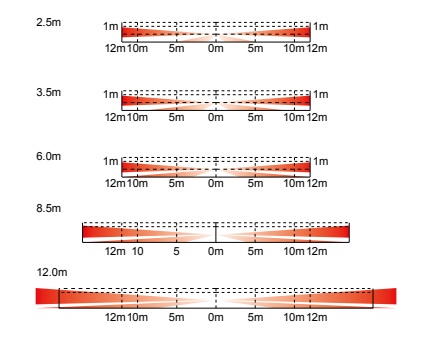
| Model | BXS-ST | BXS-AM | BXS-R | BXS-RAM |
|---|---|---|---|---|
| Page Link | ▶ See Details | ▶ See Details | ▶ See Details | ▶ See Details |
| Detection method | PIR | |||
| Installation | Wired | Wireless (Battery operated) | ||
| Anti-masking | No | ✓ | No | ✓ |
| Coverage | 24m; 12m on each side 4 zones; 2 zones on each side |
|||
| PIR distance limit | list the possible range 2.5 / 3.5 / 6 / 8.5 / 12m | |||
FlipX Series
Selectable wide & narrow area with one lens. By turning the lens upside down, the shape of detection area can be changed from WIDE to NARROW.
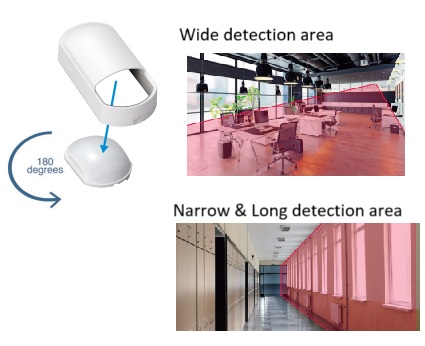
| Model | FLX-S-ST | FLX-S-DT | FLX-P-ST | FLX-P-DT | FLX-A-AM | FLX-A-DAM |
|---|---|---|---|---|---|---|
| Page Link | ▶ See Details | ▶ See Details | ▶ See Details | ▶ See Details | ▶ See Details | ▶ See Details |
| Detection method | PIR | PIR&MW | PIR | PIR&MW | PIR | PIR&MW |
| Installation | Wired | |||||
| Anti-masking | No | ✓ | ||||
| Coverage | 12m wide detection or 18m narrow detection (MW will be stopped in "Narrow" setting) | 15m wide detection or 24m narrow detection (MW will be stopped in "Narrow" setting) | ||||
2. Selecting the Right Product Based on Environmental Conditions
■ Areas where false alarms caused by small animals or vehicle headlights are a concern
Outdoor environments often present multiple factors of false alarms, such as small animals and vehicle headlights. These false alarms can compromise the reliability of the system and lead to unnecessary responses. In security applications, they may even result in missed detection of actual threats, making it essential to minimize false alarms as much as possible.
OPTEX addresses these challenges by incorporating proprietary technologies such as Double-Layered Detection Patterns and Intelligent AND Detection Logic, which significantly reduce false alarms caused by environmental factors.
Double-Layered Detection Patterns
Models: FTN-ST / FTN-AM / FTN-RAM / VXI-ST / VXI-AM / VXI-DAM / VXI-R / VXI-RAM / VXI-RDAM / WXI-ST / WXI-AM / WXI-R
OPTEX’s outdoor PIR detectors utilize the multiple detection pattern technology, two double-layered detection patterns (upper and lower) both have to be activated to generate an alarm condition. This reduces false alarms, particularly those caused by temperature changes, ligt refrection and small animals.
– Size judging function of VXI series for Double-Layered Detection Patterns
The size judging function virtually eliminates false alarms due to small animals and other moving objects like car.
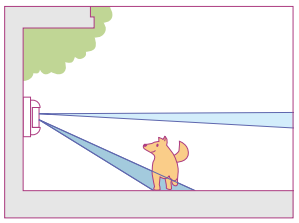
When only the lower zone detects a moving object, the unit is not activated.
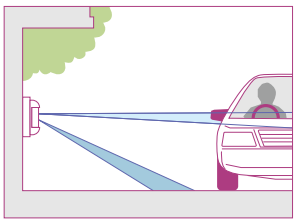
When only the upper zone detects a moving object, the unit is not activated.
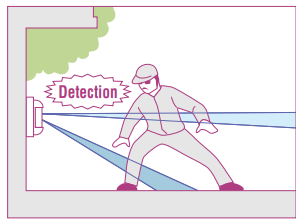
When both the upper & lower zone detect a moving object, the unit is activated.
Intelligent AND Detection Logic
Models: HX-80N / HX-80NAM / HX-80NRAM / HX-40 / HX-40AM / HX-40RAM / HX-40DAM
By utilizing originally developed pyro-elements, it creates a configuration area consisting of 94 high density detection zones. Also the AND detection pattern technology requires both detection areas have to be activated in order to generate an alarm condition making it more tolerant to false alarms caused by small animals or pets.
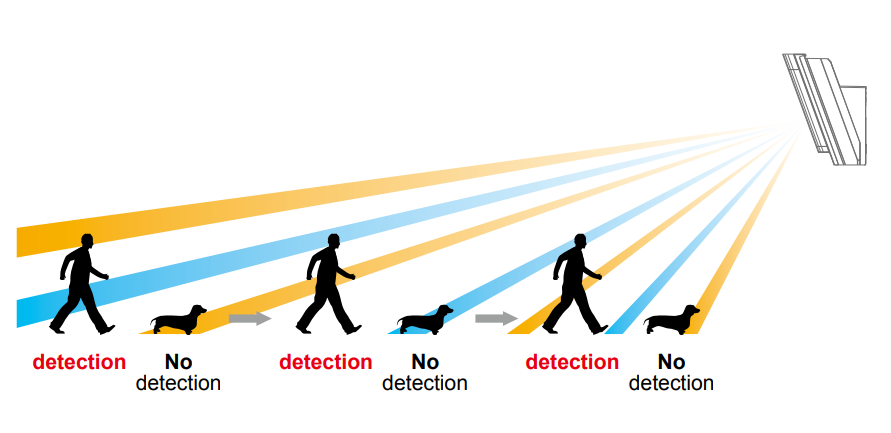
■ Areas where false alarms caused by pets are a concern
When an indoor alarm system is armed while the user is away, pets remaining in the room may trigger general motion sensors, resulting in false alarms. To prevent such incidents, it is recommended to use sensors equipped with pet tolerance features.
3. Selecting the Right Product Based on Operational Needs
■ When tampering detection is required
To detect covering or painting over the lens of sensor to attempt to obstruct sensor functionality, sensors equipped with anti-masking features are highly effective.
Anti-masking technology can immediately identify such interference and trigger an alarm. This capability helps prevent sensor neutralization and ensures continuous monitoring integrity.
OPTEX also offers models equipped with anti-masking functionality, making them effective in areas where a high level of security is required.
* Models that include “AM” in their product name are equipped with anti-masking features.
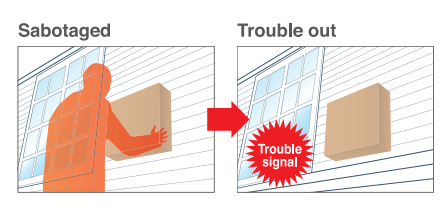
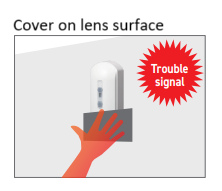
FAQ
1. Where can motion sensors be installed?
Motion sensors can be installed in a wide variety of locations, both indoors and outdoors. By selecting the appropriate product for your installation environment, you can effectively use motion sensors for objectives such as intrusion detection and lighting control.
Common installation locations include:
[Outdoors]
- Building exterior walls, windows, and entrance areas
- Gardens, backyards, and approach areas
- Parking lots and around buildings
- Material storage areas in factories or warehouses
[Indoors]
- Living room
- Corridors and entrances/exits
- Unmanned areas within warehouses
- Office floors and retail spaces
- Safes/vaults
At OPTEX, we offer a product lineup tailored to various applications, including models designed for outdoor environments, as well as highly accurate and compact models for indoor use. It is important to select detection range, angle, and functions according to the conditions and needs of the installation site.
2. Please explain about the integration between motion sensors and surveillance cameras.
Integrating motion sensors with surveillance cameras enables enhanced security, improved monitoring, and more efficient operation. When a motion sensor detects movement, it sends a signal to the surveillance camera, allowing for actions such as recording and notifying only when necessary, checking the site in real time, and automatically activating warning sounds or lights. This ensures targeted and reliable responses without unnecessary operations.
At OPTEX, we offer sensor and surveillance camera integration solutions tailored to various environments and applications.
(For details, please refer to Proactive Video Monitoring.)
With these solutions, you can build an optimal security system that meets the specific conditions and needs of your site.
3. What are the advantages of wireless motion sensors?
The advantages of wireless motion sensors are as follows:
- High flexibility in installation, as no wiring work is required
- Greatly reduced installation time compared to wired models
- Easy to deploy in existing buildings, or where wiring is difficult
- Suitable for renovation projects and temporary setups
- Adaptable to locations with physical constraints or changing layouts
Contact OPTEX
Please feel free to contact us for further information.
We are always eager to support you and propose a solution that suits your needs.








